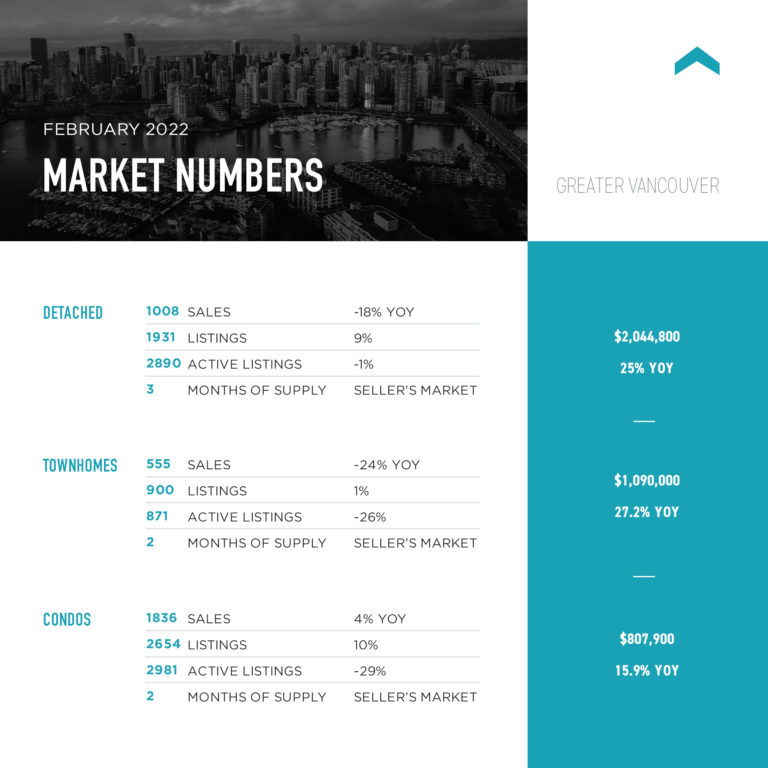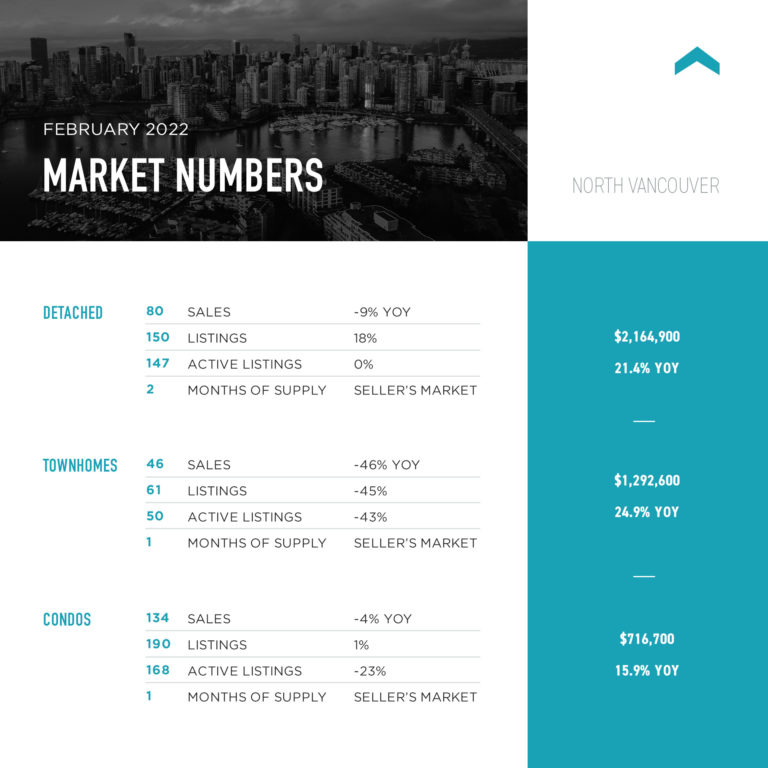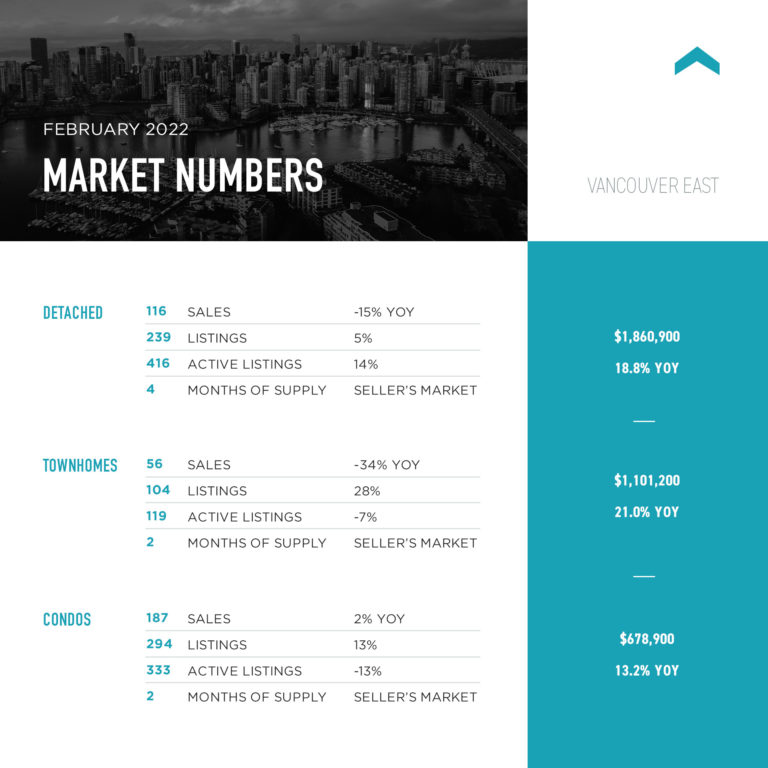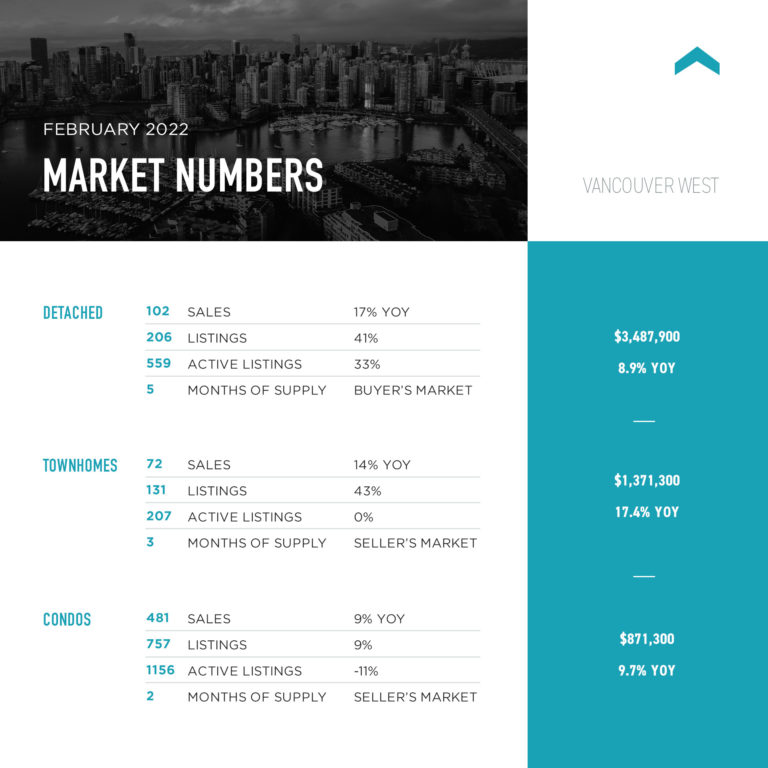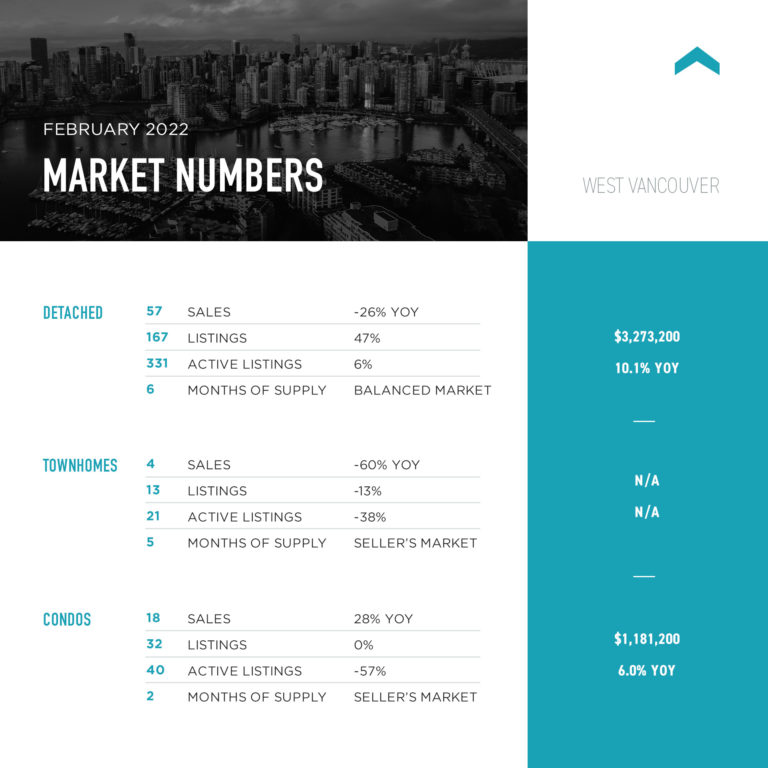February signals March will come in like a lion
February, with the highest increase in listings in eight months and the fourth-highest home sales for the month in history, set the stage for what should be barnburner in March, traditionally one of the strongest months in the Metro Vancouver housing market.
March of last year produced the highest number of new listings and the highest number of sales by month in 2021, which ended up posting the all-time annual high of almost 45,000 sales.
Download February Sales and Listings Statistics Houses Townhouses Condos
Download February Sales and Listings Statistics All Regional
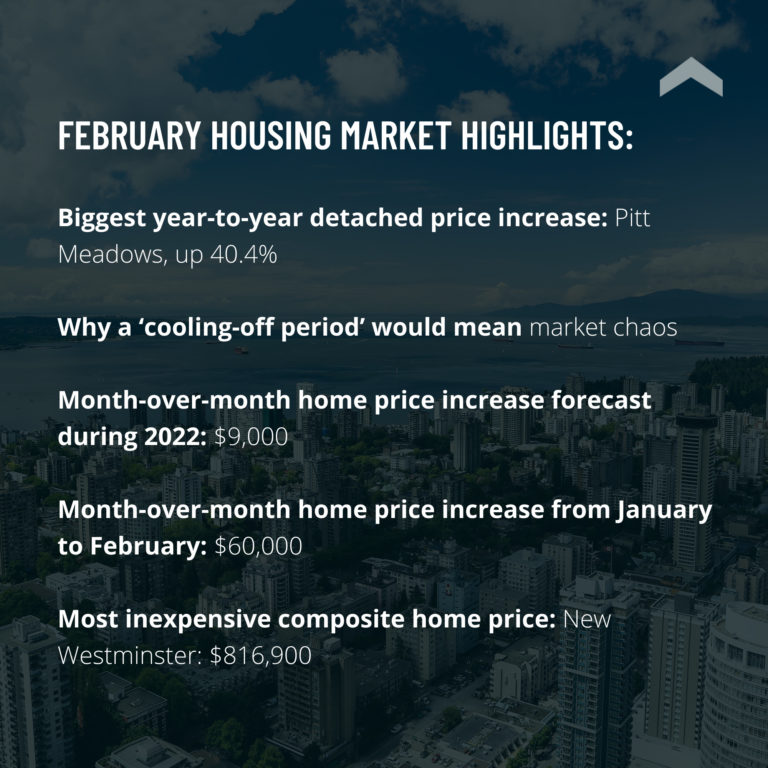
With a series of rate increases already started – the Bank of Canada lending rate increased 25 basis points to 0.50% on March 2 and a second increase is expected in April – and a continued lack of inventory, we don’t expect 2022 sales to top last year’s record. But we do believe that sales could go higher over the next two months as buyers try to get into a market with historically low mortgage rates.
In reality, even the most pessimistic forecasts for a Bank of Canada rate increases this year –175 basis points – will not have much effect on what a buyer can afford.
The average mortgage amount in Canada, according to Equifax, is approximately $371,500. For a homeowner carrying a variable-rate mortgage of 1.5% with a 25-year amortization, the monthly mortgage payment would be $1,485. A rise of 175 basis points would increase the rate to 3.25%, making monthly payments $1,807, a difference of $322 per month.
Even doubling the average local mortgage means about a $650 per month increase. But the composite home price in Greater Vancouver is projected to increase by 0.75%, or an average of $9,000, per month during 2022.
Officially, the Real Estate Board of Greater Vancouver expects total 2022 sales to decline 12.2% compared to 2021, but prices are expected to rise on average 8.9% compared to last year, with detached prices leading the way at 13% (to $2.23 million) townhouses following at 9.5% (to $1.16 million) and condo apartments posting an 8% price increase to $781,000.
Sales: There were 3,451 properties sold of all types in Greater Vancouver in February this year compared with 2,329 sold a month earlier and 3,852 sales in February 2021. Sales in February were 30% above the 10-year average for the month and nearly 50% higher than in January 2022.
Listings: February brought 5,573 new listings to the market which was above the 5,191 that came on the market in February 2021. The number of new listings in February were 15% above the 10-year average. This still left only 7,062 active listings in Greater Vancouver at the end of February – an all-time low for the month. The one glimmer of hope is that week-by-week in February, the number of new listings increased. There was an average of 251 new listings a day in the first week to an average of 350 new listings a day in the last week of February.
But even with the increase in new listings we are still sitting with 2-month’s supply of homes available for sale in most areas. North Vancouver, New Westminster, Port Moody, Port Coquitlam, Tsawwassen, Pitt Meadows and Maple Ridge are among markets with just a 1-month’s supply of homes for sale.
So, barring a huge increase in listings, the start of the spring buying season should continue to see the higher prices and multiple offers that characterize a lack of supply amidst high demand.
Cooling off period means chaos
We can only hope that a provincial government proposal for a ‘cooling off’ period does not arrive to skew and confuse the spring housing market.
The main result of the cooling off period would be less listings on the market, which is the exact opposite of what is needed.
The government proposal is for a period (length yet to be determined) after an accepted offer in which the buyer could get out of the transaction.
This is among the most unthinkable ideas this government has come up with, which is saying a lot. The effect would be chaos, with a cascading effect. A seller would not know for a week or so whether the sale was actually going through. If it didn’t, the next buyer would also have a mandatory grace period, and so on.
Meanwhile, the seller would be trying to buy another home, but that transaction would also be delayed by the cooling off period. And given all offers would have this same mechanism, the only strategy left for buyers is to compete on price, and price alone. How is that going to tame our housing market? We would recommend, that, at least the government allow sellers and buyers to agree to drop the cooling off period. Which we think nearly every buyer and seller would agree to.
Breakdown of the February numbers, by market
Greater Vancouver: Total housing sales in February, at 3,451, were up nearly 50% in February compared to January, but the performance was mixed.
As we predicted here, condo apartment sales continued to dominate housing sales across Greater Vancouver in February. Buyers are moving towards apartments more than we have seen in the last two years. There was an increase of 5% in the number of apartments sold compared to February 2021, while there was a decrease of 24% in the number of townhomes sales and detached house transactions were down 17% compared to February 2021.
The key reasons for the condo sales surge are a greater supply and lower prices – at a benchmark of $807,900 in February – than other property types, plus demand from investors. With vacancy rates back to their record lows, investors know there is a need for rental housing – something the governments in all cities haven’t been able to adequately supply.
But the condo apartment supply was down 29% year-over-year in February and some larger new condo projects have stalled, stopped or are completely pre-sold. A shortage is looming and benchmark prices have risen15.9% from a year ago.
After 10 years of consultation and seven presentations from the developer, in February Port Moody sent the city’s largest housing development to a further round of public hearings. The biggest housing project on the Burnaby-Coquitlam border, Lougheed Town Centre, closed its presentation centre March 1after selling out 95% of 1,500 condos in the first phase. (The last 3 bedroom units start at $1.4 million). In Richmond, a planned 800-unit condo project has stopped and the site was fenced in and closed in February.
An indication of the future of new condo values is the prices being achieved for suburban multi-family land: in Burnaby’s Metrotown a 1.4-acre potential condo site recently sold for the equivalent of more than $31 million per acre; less than an acre of multi-family development land in New Westminster sold in February for $27.5 million. In Surrey, a 0.8-acre residential assembly sold for $12 million. These are unparalleled land prices that must eventually be reflected in the end product.
Investors remain active in condo sales, which is fortunately increasing the rental supply in a market where the rental vacancy rate has fallen to around 1 per cent.
The number of active listings for townhouses continues to be a challenge with only a 1-month’s supply in Greater Vancouver, and active listings down 26% year-over-year. The February benchmark price for a townhouse increased nearly 6% – that is more than $64,000 – from January to $1,090,000. Yet only 90 new townhouses had started in all of Metro Vancouver (which includes Surrey and Langley) this year as of February 1.One issue that adds to the cost of townhouses is civic fees. For instance, a new 39-unit townhouse project in Richmond, which is offering innovative townhomes with small secondary rental suites, is ironically being charged $358,000 for the city’s “affordable housing fund.”
Meanwhile, the number of detached home listed for sale is at 3-month’s supply. Sales dropped year-over-year in February due to a lack of choice and buyer resistance to a record high benchmark price of $2,044,800.
Fraser Valley: There were 1,352 sales through the Fraser Valley Real Estate Board in February, up 38% from a year earlier and 39% higher than in January 2022. New listings, however, dropped 15% year-over-year to 2,557, and total active listings were down to 5,741 homes. The strata shortage is severe in some markets. In Langley for example, for every 10 active townhomes in February, six sold and in Cloverdale there were only 26 total condo listings and 20 of them sold.
The Board reports more traffic at open houses, more multiple offers and a slight increase in year‐over‐year prices. At $971,300, the benchmark price for a detached house was up 1.1 per cent compared to January. The benchmark townhouse price increased 1% from January to $523,200. At $414,500, the benchmark price for condo apartments in the Fraser Valley increased 1.5 per cent compared to January.
Vancouver Westside: We are seeing a few detached house price corrections on the West Side – in one case a 10% reduction on $3.4 million February listing – but don’t believe it is a trend, just something to watch. Detached sales reached 102 houses in February, up 56% from January and 17% higher than in February 2021. The median detached house price in February was $3,655,000, up from $3,332,000 a year earlier. Total residential sales were 665, up 49% from January 2022 Active listings were 1,942 at month’s end compared to 1at the end of January 2022. With 131 townhouse listings and 73 sales, the sales-to-listing ratio for townhouses was 56%, indicating a seller’s market. The benchmark townhouse price is now $1,371,300, up 4.5% from January. With 498 sales and a sales-to-listing ratio of 64%, condo apartments were by far the most active Westside sector in February, even as the benchmark condo price reached $871,500, up 11.1% from a year ago.
Vancouver East Side: The Real Estate Board of Greater Vancouver is forecasting that East Side home prices will rise a further 10.5% this year and February indicated that may be conservative. Composite home prices were up 4.5% from a month earlier. If that pace even slowed by half, the annual price increase in 2022 would surpass the 21% price rise in 2021. Despite a new benchmark high of $1,860,900, the East Side led every sub-market but Maple Ridge-Pitt Meadows with 117 detached house sales in February. Total residential sales on the East Side in February were 359, up 30% from January and 12% higher than a year earlier. The 190 condo sales led the action, with the benchmark condo price rising 4.4% from January to $678,900. New listings in February were up 35% compared to January 2022 and up 12% compared to February 2021. There is about a 2-month’s supply of total residential listings, with a sales-to-listings ratio of 55%, a ratio that has held steady for the past year.
North Vancouver: Even with an unprecedented median price of $2,303,500, 75% of the detached houses listed for sale sold in February. The 80 detached sales were up from 37 in January and down 10% from February 2021. Townhouse and condo apartment sales were also higher than a month earlier, with townhouse sales more than doubling to 46 at a benchmark of $1,292,000; and 134 condos selling at a benchmark of $716,700. Total active listings were at 380 compared to 469 at the same time last year and 291 at the end of January. New listings in February were up 55% compared to January 2022. Month’s supply of total residential listings is back down to 1 month’s supply (seller’s market conditions) and the sales-to-listings ratio is running at a tight 64%. Congratulations are in order for North Vancouver City: after 10 years of delays, the $201.8 million Harry Jerome Community Recreation Centre and Silver Harbour Centre in central Lonsdale starts construction next month.
West Vancouver: Total February housing sales soared 78% from January to 80 transactions, while active listings increased to 417 units, up from 358 in January. Detached house sales naturally dominated the market, accounting for 58 sales in February at a benchmark price of $3,273,200. West Vancouver, which had 18 condo apartment sales in the month, is the only Metro municipality where the benchmark condo sells for more than $1 million: it was $1,181,200 in February.
West Vancouver has fairly healthy 5-month supply of listings and is one of the few balanced markets in the Lower Mainland, with a sales-to-listing ratio at 37%.
Richmond: There is a bit of a condo boom in Richmond, with 400 condo apartments selling so far this year, including 225 in February. Total condo listings were down in February compared to January, to 311, but the sales-to-listing ratio had risen to 72%. The benchmark condo price has shot up nearly 9% since December 31, 2021, and is now at $800,300. Total Richmond sales in February were 397, up 17% from 2022, but down 12% from February 2021. New listings in February were up 27% compared to January 2022, and the sales-to-listings ratio is 56%, a mild seller’s market.
Ladner: The number of detached listings in February rose to 45, an increase of 14 from January. There was only a slight increase in townhome listings (4, compared to 2) and apartments (8, compared to 2) from the previous month. Prices continue to ascend with the benchmark price of a single family detached home in Ladner increasing 5.8% from January to $1,543,800. Ladner townhouses increased by 6.1% to a benchmark price of $915,500 while apartments went up 2.7% to $620,200.Total units sold in February were 26, up 18% from January 2022, but down 67% from February 2021. Month’s supply of total residential listings is steady at 2-month’s supply (seller’s market conditions) and the sales to listings ratio is 46% compared to 61% in January 2022 and 74% in February 2021.
Tsawwassen: The benchmark price for a single-family detached house in Tsawwassen rose by 4.9% from January to 1,637,500. Townhouse benchmark prices climbed 6% to $992,800 and apartments rose 2% month to month to $672,400. New listings in February were up 29% compared to January 2022, but down 2% compared to February 2021. Month’s supply of total residential listings is down to a 1-month’s supply in this seller’s market. The sales to listings ratio is72% compared to 54% in January 2022.
Burnaby East: Burnaby East has the highest condo apartment prices in Burnaby, at $801,000, and condo prices were up 5.1% in February compared to January and are 19.9% higher than a year earlier. The action reflects the condo construction action that has defined the Edmonds area over the past few years. The benchmark townhouse price in Burnaby East is $794,900, the lowest among Burnaby’s three distinct markets. The typical detached house sells for $1,729,300, also the lowest for a house in Burnaby. Total new listings in February were up 86% compared to January 2022. February’s sales-to-listings ratio of 52% compares to 71% in January 2022, and 64% in February 2021.
Burnaby North: Total residential sales in February were 226, up 59% from January and 17% higher than in February of last year. Despite a rally of new listings, total active listings in Burnaby North reached only 283 in February and the sales-to-listing ratio of 72% compared to 60% in January 2022. Burnaby North’s market is dominated by condominium listings and sales. The benchmark condo price is $799,900.
Burnaby South: This is overall the most affordable housing enclave in Burnaby, but the gap is narrowing. In February, the composite home price was $1,157,200, up 5% from a month earlier and the lowest in Burnaby. The benchmark detached house price, however, jumped to $1,983,000, the highest in the municipality. Townhouse and condo prices are both lower than the Burnaby average, at $836,200 and $749,200, respectively. Total active listings were at 312 in February, compared to 528 at that time last year and 283 at the end of January. The current sales-to-listing ratio in this seller’s market is 70%.
New Westminster: The Royal City is seeing amazing tower condo construction and sales. On March 11, the second 24-hour concrete pour in a year takes place as 429 concrete trucks will pour in rotation for a 46-storey condo tower, which is flanked by a 53-storey condo high rise, one of the largest in Metro Vancouver, which is under construction and totally sold out. In February, 103 resale condos sold in New Westminster, up from 73 in January and the median price rose about $30,000 in the month to $640,000. Condos are the dominate sector, accounting for nearly 80% of all sales in the city. The sales-to-listing ratio for condos is 72%. The emphasis on condos means that New Westminster has the lowest composite home price in Greater Vancouver at $816,900.
Coquitlam: Coquitlam, the largest of the Tri-City markets, saw an increase in listings, sales and housing prices in February compared to a month earlier. Total sales were up 52% from January, at 264 transactions, while new listings increased 69% in the same period and the benchmark composite price increased 5.2% to $1,265,700. As in most markets, condo apartments led the parade, accounting for 143 of the sales and posting a 5.4% month-to-month price increase to a benchmark of $674,400. The supply of total residential listings is steady at a 2-month’s supply (seller’s market conditions) and the sales to listings ratio is 59% compared to 66% in January 2022.
Port Moody: There are 59 nervous single-detached owners in Port Moody, and their concern is a lesson to owners who get involved in a land assembly. In this case, the Coronation Park-area owners sold to a major developer, but payment for the houses is tied to the developer getting final approval from Port Moody council for a large strata development. So far that has taken seven years and seven presentations to the city, but the latest attempt was sent back to another round of public hearings at the end of February. We can only hope the house owners will be paid the current value, because the benchmark price of a Port Moody detached house has increased 56.8% in the last five years alone, to $2,102,100 as of February, and is increasing by 5% per month so far this year.
Port Moody saw total sales of 87 homes in February, up 53% from a month earlier. Active listings were 97 at month end compared to 140 at that time last year and 93 at the end of January. There is just a 1-month supply of residential listings, and the sales-to-listings ratio is 73% compared to 71% in January 2022.
Port Coquitlam: Port Coquitlam has posted the highest price increases in the Tri-Cities over the past year, with the composite benchmark up 29.5% to $1,085,600 in February, while its benchmark detached house surged 35.8% to $1,542,600, still the lowest price among the three municipalities. Total units sold in February reached 108, up 40% from January, but down 122 from a year earlier. New listings were up 46% compared to January 2022, but down 11% compared to February 2021. Month’s supply of total residential listings is steady at 1 month’s supply (seller’s market conditions) and sales to listings ratio is 71% compared to 73% in January 2022 and 71% in February 2021.
Pitt Meadows: Pitt Meadows, along with Maple Ridge is expected to post the highest price increases in Metro Vancouver proper this year, according to a Real Estate Board of Greater Vancouver forecast, with the composite price rising 12.5% to $1,007,000 by the end of this year. Pitt Meadows was once among the most affordable markets. But that has changed. The benchmark detached house price in Pitt Meadows in February reached a record high of $1,497,200 after a 40.4% increase from a year earlier, the highest year-over-year increase in Metro Vancouver. Meanwhile, listings are vanishing: there were just 37 active listings in February and 35 of them sold. The overall sales to listing ratio is running north of 70% and there is only a 1-month supply of homes on the market.
Maple Ridge: Maple Ridge is seeing a population boom, with the 2021 census showing the population increased to 90,990 last year, up 10.6% from 2016. This is twice as fast as the Canadian average. By comparison, Vancouver grew at a rate of 4.9%, and Surrey 9.7% in the same time frame. The housing supply is trailing population growth, though listings are rising. In February, there were 301 active listings, down from 352 last year, but up from 201 in January 2022. The sales-to-listing ratio is 62%. A seller’s market, the detached house price in February had soared 40% from a year earlier and was up 6% from January to $1,361,600. With the exception of the Sunshine Coast, this is still the lowest detached house price in Greater Vancouver.
Surrey: Surrey is expected to reach a total population of 714,300 by 2031, at which time it will have surpassed Vancouver as B.C.’s largest city. But Surrey is already the bigger player when it comes to delivering key homes and keeping housing prices relatively low. As of February 1, for instance, there were 1,005 new townhouses under construction in Surrey, compared to 134 in the city of Vancouver. The benchmark price of a Surrey townhouse is $565,000. It is $1.1 million in Vancouver. The overall composite price of a Surrey home is $836,800, compared to $1.35 million in Vancouver. This is a major reason why Surrey’s population is growing twice as fast as Vancouver’s.
